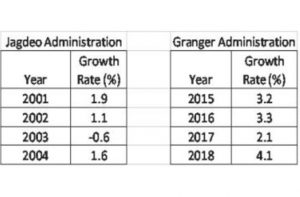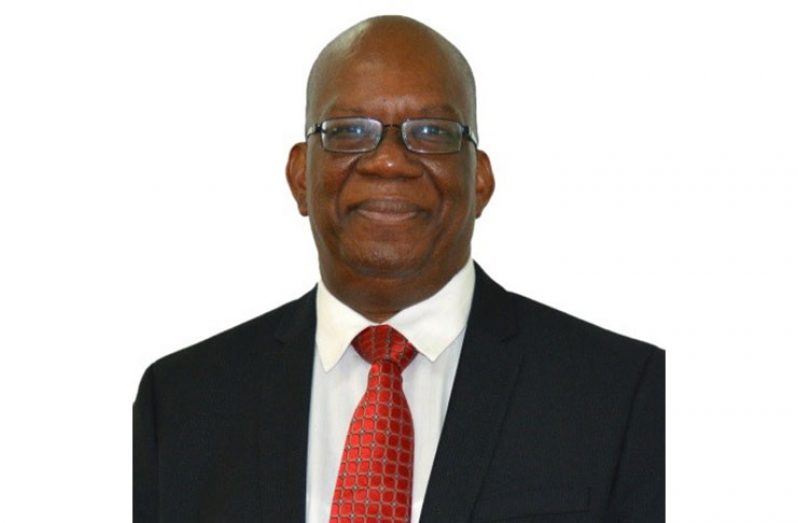…growth rate pegged at 4.5%; to meet double digits from next year
WITH a vibrant oil and gas industry on the horizon, Guyana’s economy will start growing by double digits from next year.
This was according to a top source, who said that Guyana’s economy will be thriving on the success of various sectors and the advent of petroleum. The country’s potential and acceleration was also proven when the Nasdaq Stock Exchange had reported that Guyana has the fastest growing economy in the world.
The New York-based stock market, the second largest in the world, made note of Guyana’s projected growth rate of 16.3 per cent during the four-year period 2018-2021 in its report.
It said that with a Gross Domestic Product (GDP) size of $3.63 billion (2018 Rank: 160), a growth rate of 4.1 per cent in 2018 and 4.6 per cent in 2019, Guyana’s economy is expected to grow by 33.5 per cent and 22.9 per cent in 2020 and 2021 respectively.
Minister of Finance, Winston Jordan is expected to add more flare to the projections, with real facts on the performance of the economy for the first half of the year today. The minister, at a press conference today, is expected to announce that the country registered economic growth of over four per cent and that the private sector has accessed billions in financial capital, among other things.
The minister already let some of the cat out of the bag, noting that the country recorded economic growth of four per cent for the first half of the year. He made the announcement during an interview on the National Communication’s Network’s ‘Insight’ Programme on the Voice of Guyana, on Saturday.
“At the half year we have grown four per cent year-on-year, which is basically measuring the first half of the year to the same period last year,” said Jordan, adding that it is significant from the current standpoint. He made the comment to clear the air on doubts which were created by “certain people.” In that regard, Jordan said the A Partnership for National Unity and Alliance For Change (APNU+AFC) government has kept the economy growing from day one.
Meanwhile, Economist Rawle Lucas has endorsed Minister Jordan’s point, noting that it is clear that the noise from the Leader of the Opposition, Bharat Jagdeo has drowned out the sound of the good performance by the President David Granger-led administration, since 2015. “With by far a better record than Jagdeo as a manager of the economy, the people of Guyana should not discriminate against Granger being returned to office to continue rebuilding and expanding the economy,” said Lucas in a letter. The economist drew facts from the Bank of Guyana, to measure the performance of Jagdeo as President of Guyana from 2001 to 2004 and President Granger’s performance from 2015 to now.
GRANGER VS JAGDEO
According to Lucas, in the first four years of the Jagdeo administration, the performance of the economy was dismal. The highest growth rate of the economy was 1.9 per cent. In the case of President Granger, the highest growth rate was 4.1 per cent.

Granger’s best performance was more than two times better than that of Jagdeo. Under the leader of the opposition, the economy grew on three occasions and contracted on one occasion. The economy never contracted under President Granger.
“The slowest growth rate under Granger was better than the best rate of Jagdeo. Persons might be curious about what happened to the economy in 1999 and 2000. Former President Jagdeo took office in August 1999. Thus, his first full year in office was 2000. In that year, the economy contracted 1.4 per cent.
Despite an overall dismal performance for five years of handling the economy, the people of Guyana did not discriminate against Jagdeo and gave him a second chance at managing the economy,” said Lucas.
On the other hand, even though the Guyana economy continued to grow each year after elections in 2015, much criticism has been heaped on the Granger administration about its performance.
Very quickly those who opposed the new government tried leading the people of Guyana to believe that the sky was falling and doomsday was upon the country, said Lucas. The economist, however, believes that the Jagdeo administration did not manage the Guyana economy very well. In contrast, he contended that the President Granger was able to take what he was given and maintain positive growth rates of the economy throughout the period of assessment.
Guyana is on the verge of growing again and the latest estimate is for growth to be 4.5 per cent at the end of the year, but Minister Jordan believes that people can do “mischief” to derail the growth.
With the possibility of growth being derailed, Jordan said government will do all in its power to ensure that growth is held in check. As efforts to keep things in order continue, the minister pointed out that revenues are continuing to be buoyant.
“This is allowing us to spend in a number of areas…there have been wells in communities, roads, houses and lights where people never had…quite a lot is going on and it is reflective of the fact that we can do these things because our revenue profile has gone up sharply.
“More people are on the tax roll…the opposition tried to beat us on our head about giving amnesty, but it was able to bring us somewhere of $10 billion in arrears…they are all on the tax roll now,” said Minister Jordan.
In addition to being able to increase revenues, the Economic Commission for Latin America and the Caribbean (ECLAC) had confirmed that Guyana’s public debt continues to be the lowest in the Caribbean.
ECLAC, in its 2019 Economic Survey of Latin America and the Caribbean, says that the Caribbean country with the lowest level of public debt is Guyana, with a public debt of 41.7 per cent of the country’s Gross Domestic Product (GDP). The report, when compared to that of 2018, shows that there was a 5.2 per cent decrease in the country’s public debt. In 2018, it was reported that public debt was 46.9 per cent of the country’s GDP.
Going forward in 2019, ECLAC has projected that interest payments on public debt are expected to fall in Guyana and Barbados.




.png)









